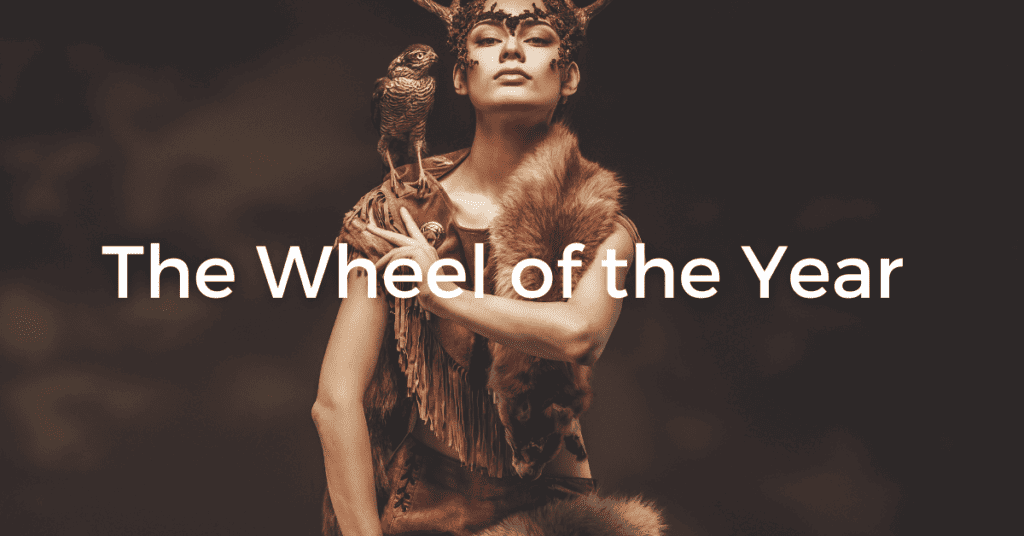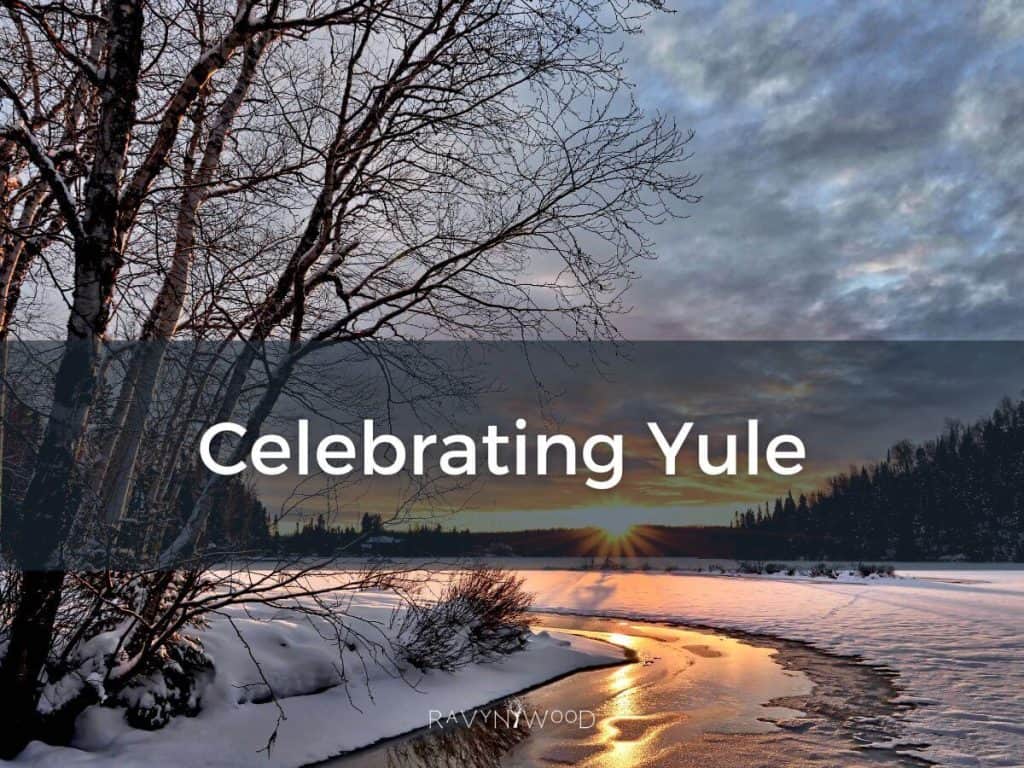The Wheel of the Year is a sacred way to connect with the natural rhythms of Mother Earth. When you align yourself to these rhythms, it becomes a beautiful way to move through the world with intention and mindfulness.
In my own healing and spiritual journeys, I’ve used this sacred path as a way to heal, grow, shift, and gain a deeper understanding of the world around me and the world within me.
In this post, we’ll take a journey through the 8 points on the Wheel of the Year known as the Sabbats so you can discover the themes and significance of each one and perhaps begin your own journey through them.
The Wheel of the Year – Sabbats & Themes
There are eight seasonal festivals that are celebrated as we move through the Wheel of the Year. These are also called Sabbats.
Many cultures throughout history have acknowledged and celebrated these festivals. While they may have ancient origins, today, they are woven into modern witchery and other nature-based spiritual practices.
Let’s begin this journey through each of the Sabbats with Samhain.
Samhain Sabbat
Samhain, celebrated on October 31 is one of the most significant sabbats on the Wheel of the Year. Samhain marks the end of the harvest season and the beginning of the dark months of the year.
This is a time to honor the ancestors and the spirits of the dead, since the veil between the worlds is at its thinnest now.
Many witches honor the dead by setting up ancestor altars or leaving offerings for their loved ones who have passed on.
Samhain is also a time to reflect on the past year and release anything that no longer serves us. As we move into the darkest time of the year, we’re called to turn inward and focus on our inner growth and transformation.
Whether you celebrate Samhain with a quiet ritual or a festive gathering, it’s a powerful time to connect with the cycles of nature and honor the mysteries of life and death.
Samhain season might just be my favorite.
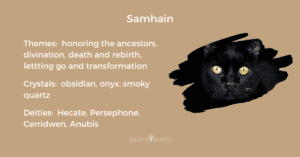
Want to know more about Samhain?
See these posts:
Embrace Your Roots: Honoring the Ancestors at Samhain
Celebrating Samhain: A Personal Perspective
Yule Sabbat
Yule falls around December 21. It’s also known as the Winter Solstice. This is the time of the longest night of the year and the return of the sun.
It’s a time to celebrate the rebirth of the sun and the renewal of life. Lighting candles or bonfires in our rituals and celebrations symbolize the return of the light to the earth. Without the sun, life would be impossible on this planet, so this is also a time to celebrate life.
We reflect on the past year and set intentions for the coming year now. Releasing what no longer serves us before moving into a new calendar year.
This is the perfect time to create vision boards, reflect on the lessons we’ve learned this year and do fire ceremonies to release the past.

Want to know more about Yule?
See this post:
You might like this too: The Celtic Omen Days: A Personal Journey
Imbolc Sabbat
Imbolc is observed on February 2 and marks the coming of spring and the return of the light. The sun’s power is growing now, and the earth is beginning to awaken.
As the earth begins to stir from its winter slumber, we too can open to the new possibilities and opportunities that the coming year holds.
Imbolc is a powerful time to connect with the energies of renewal.
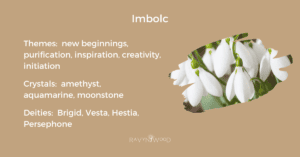
Want to know more about Imbolc?
See this post:
Spring Equinox/Ostara Sabbat
Spring Equinox also called Ostara, marks the return of spring and the balance between light and darkness. It’s celebrated around March 21st. This is a time of new beginnings and celebrating the fertility of the earth.
This Sabbat is also a time to celebrate the balance between light and darkness, as the days and nights are of equal length.

Want to know more about Spring Equinox/Ostara?
See this post:
6 Simple Ways to Celebrate the Spring Equinox
Beltane Sabbat
Beltane is celebrated on May 1, and marks the beginning of summer, and celebrates the fertility of the earth. We honor the abundance and vitality of nature and celebrate the union of masculine and feminine energies. Sometimes referred to as the union of the God and Goddess.
Beltane is also a time to celebrate the power of love and passion, as the energies of the season are ripe for new beginnings and romance.
As the earth comes into full bloom, we can embrace the fullness of life and all its possibilities, making this a powerful time to connect with the energies of abundance, passion, and vitality.
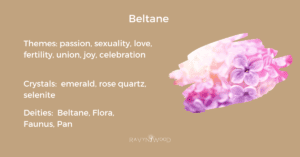
Want to know more about Beltane?
See this post:
6 Simple Ways to Celebrate Beltane
Summer Solstice/Litha Sabbat
Summer Solstice, also known as Litha, marks the peak of summer and the longest day of the year. Celebrated around June 21, this is a time to honor the vitality of nature and to celebrate the power of the sun.
Traditionally, Summer Solstice was a time to honor the sun god and the power of the sun to bring life and growth to the earth.
This is also a time to celebrate the abundance of the earth and the fruits of the summer harvest.
As the sun reaches its highest point in the sky, we can powerfully connect with the energies of growth, abundance and vitality as we’re called to embrace the fullness of our own power and potential to bring our visions and dreams to life.

Want to know more about Summer Solstice?
See this post:
Summer Solstice: 6 Easy Ways to Honor the Longest Day of the Year
Lammas/Lughnasadh Sabbat
Lammas, also known as Lughnasadh, marks the beginning of the harvest season.
Celebrated on August 1st, it’s a time to honor the bounty of the land and to give thanks for the blessings of the season.
Traditionally, Lammas fell at the time of the wheat harvest and rituals were done to honor the god Lugh, who presided over the harvest.
Lammas is also a time to reflect on the cycles of life and the balance of light and dark. As the days begin to shorten and the darkness of winter approaches, we can use this time to reflect on the gifts of the past year and to set intentions for the coming season.
Lammas is a powerful time to connect with the energies of abundance, gratitude, and reflection as we give thanks for the blessings of the earth and honor the cycles of life.
We’re reminded that we can create positive change in the world around us.
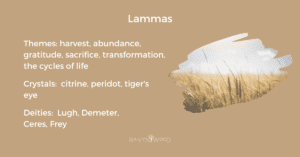
Want to know more about Lammas?
See this post:
Celebrating Lammas: How to Celebrate the First Harvest Festival
Fall Equinox/Mabon Sabbat
Fall Equinox, also known as Mabon, marks the second harvest festival of the year and the balance of light and dark.
Celebrated around September 21st, this is a time to honor the abundance of the earth and to give thanks for the blessings of the season.
Fall Equinox is also a time to reflect on the balance in our own lives and to consider the changes that lie ahead. As the days continue to shorten and the darkness of winter approaches, we can use this time to focus on inner reflection and personal transformation.
During this Sabbat, we’re invited to connect with the rhythms of nature and to embrace the changes and transformations of the season.
By honoring the abundance of the earth and reflecting on our own inner balance, we can cultivate a sense of gratitude, purpose, and connection that will guide us through the coming months.
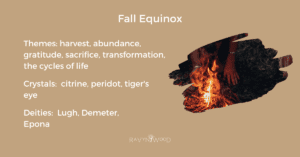
Want to know more about Fall Equinox?
See this post:
Summary
The Wheel of the Year is the sacred framework for spirituality as well as a path to personal growth and transformation.
As we align and connect to the cycles and rhythms of nature, we’re offered unique opportunities to develop our spiritual path and ourselves through intentionally working with the themes of each season and Sabbat. You’ll notice that many of the themes overlap or are repeated, and this is because of the interconnectedness of all things. One of the true gifts of following this path is the deep understanding that we are not apart from nature, but a part of it.
Whether you’re new to witchery or have been practicing for a long time, the Wheel of the Year is a guide that will help you create or deepen your connection to the natural world, helping you cultivate a deeper sense of peace and purpose in your life as you travel along it, year after year.
Blessed be.
Before you go…
Come walk the path with me.
If this post stirred something awake in you, you’ll love what I share in my emails.
Each week, I send notes from the wild edges of Ravynwood—filled with seasonal rituals, earth-based reflections, and magickal tools to support your solitary practice.
✨ You’ll also get access to my free guide: 5 Nature Rituals to Reconnect You to the Sacred.
➡️ Click here to subscribe and begin your journey back to living your magick every day!
You might like these too:
Healing Through the Wheel of the Year – March’s Ancient Wisdom
Everything offered here – See all our offers in one place

